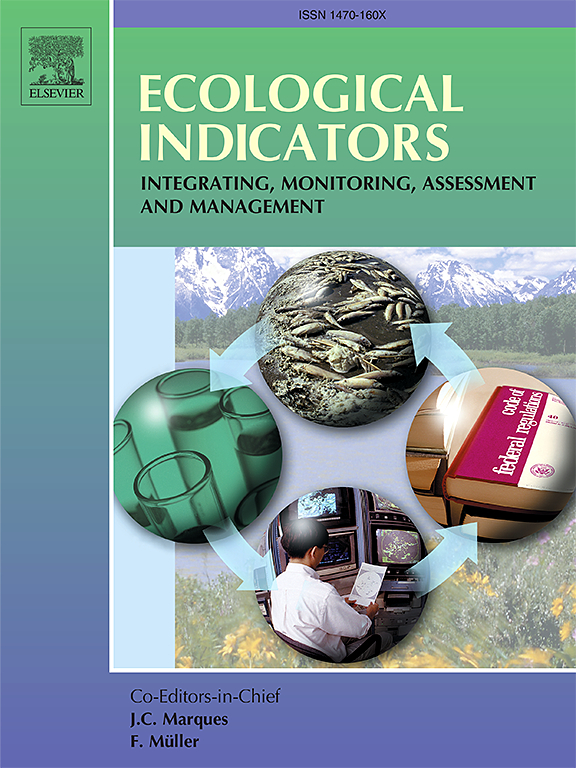中国湖泊藻华的时空动态及其驱动因素:多物候指数分析
IF 7
2区 环境科学与生态学
Q1 ENVIRONMENTAL SCIENCES
引用次数: 0
摘要
富营养化引起的藻华对淡水生态系统和人类水安全构成全球性威胁。现有研究缺乏物候指标的标准化定义和方法,妨碍了定量比较和综合空间异质性评估。利用2000-2023年的MODIS数据,利用9个指标系统检索了中国4个主要湖区(不包括青藏高原)359个湖泊(10 km2)的3个物候特征(频度、持续性和覆盖度)。结合时空分析、层次聚类分析和驱动因素分析来阐明AB动态。主要发现包括:(1)63.3%(228个)湖泊经历AB,其中46.9%呈显著增加趋势;空间异质性表现为南部湖泊暴发时间较早,中部地区持续时间较长,小湖泊暴发频率较高,且均呈上升趋势。(2)分层聚类识别出1型(面积小、持续时间短、频繁严重AB)、2型(面积大、频率低、持续时间长、覆盖范围广)、3型(面积中较大、频率高、持续时间长)和4型(面积中较大、频率高、覆盖范围广)4种湖泊类型,其空间分布与气候和人类活动有关。(3)类型1和类型3以自然因子(温度和降水)为主;除类型4外,覆盖度主要受人类活动(耕地和人口密度)的影响。这一多物候框架阐明了中国湖泊AB的时空格局和驱动因素,为生态保护和水质管理提供科学依据。本文章由计算机程序翻译,如有差异,请以英文原文为准。
Spatiotemporal dynamics and drivers of algal blooms in chinese lakes: A multi-phenological index analysis
Algal blooms (AB) caused by eutrophication pose a global threat to freshwater ecosystems and human water security. Existing studies lack standardized definitions and methodologies for phenological indicators, hindering quantitative comparisons and comprehensive spatial heterogeneity assessments. Using daily MODIS data (2000–2023), this study systematically retrieved three phenological features (Frequency, Persistence and Coverage) with nine indicators for 359 lakes (>10 km2) across four major lake zones in China (excluding the Tibetan Plateau). Spatiotemporal analysis, hierarchical clustering, and driving factor analysis were integrated to elucidate AB dynamics. Key findings include: (1) 63.3 % (228) of lakes experienced AB, among which 46.9 % showing significant increasing trends. Spatial heterogeneity revealed earlier outbreaks in southern lakes, prolonged persistence in central regions, and higher frequency in smaller lakes, and all three features exhibited upward trend. (2) Hierarchical clustering identified four lake types: Type 1 (small area, short persistence, frequent severe AB), Type 2 (large area, minimal frequency, persistence and coverage), Type 3 (medium-large area, high frequency and long persistence), and Type 4 (small-medium area, highest frequency and coverage), with spatial distributions linked to climate and human activities. (3) Natural factors (temperature and precipitation) dominated Frequency and Persistence (temperature-driven in Types 1 and 3; precipitation-driven in Type 4), while Coverage was primarily influenced by human activities (cropland and population density), except in Type 4. This multi-phenological framework clarifies spatiotemporal patterns and drivers of AB in Chinese lakes, offering scientific insights for ecological protection and water quality management.
求助全文
通过发布文献求助,成功后即可免费获取论文全文。
去求助
来源期刊

Ecological Indicators
环境科学-环境科学
CiteScore
11.80
自引率
8.70%
发文量
1163
审稿时长
78 days
期刊介绍:
The ultimate aim of Ecological Indicators is to integrate the monitoring and assessment of ecological and environmental indicators with management practices. The journal provides a forum for the discussion of the applied scientific development and review of traditional indicator approaches as well as for theoretical, modelling and quantitative applications such as index development. Research into the following areas will be published.
• All aspects of ecological and environmental indicators and indices.
• New indicators, and new approaches and methods for indicator development, testing and use.
• Development and modelling of indices, e.g. application of indicator suites across multiple scales and resources.
• Analysis and research of resource, system- and scale-specific indicators.
• Methods for integration of social and other valuation metrics for the production of scientifically rigorous and politically-relevant assessments using indicator-based monitoring and assessment programs.
• How research indicators can be transformed into direct application for management purposes.
• Broader assessment objectives and methods, e.g. biodiversity, biological integrity, and sustainability, through the use of indicators.
• Resource-specific indicators such as landscape, agroecosystems, forests, wetlands, etc.
 求助内容:
求助内容: 应助结果提醒方式:
应助结果提醒方式:


